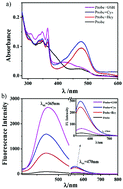A two-separated-emission fluorescent probe for simultaneous discrimination of Cys/Hcy and GSH upon excitation of two different wavelengths†
Abstract
It is challenging to simultaneously discriminate two or three biothiols from each other due to their structural similarities as well as reactions sites. The development of multiple-signal fluorescent probes would be a promising way to overcome this issue. Herein, a two-separated-emission fluorescent probe for biothiols was developed based on the combination of nitrobenzofurazan (NBD) and phenanthroimidazole fluorophores linked by a facile ether bond. In the presence of Cys and Hcy, the probe in DMF–H2O demonstrates two separate fluorescence emissions at 480 and 550 nm upon excitation of two independent wavelengths. However, addition of GSH to the probe only leads to blue fluorescence at 480 nm. This difference can be reasonably ascribed to the fact that the NBD–GSH intermediate, unlike NBD–Cys/Hcy, cannot undergo an intramolecular cyclization–rearrangement reaction. The probe exhibits a rapid response with low limits of detection (14.7 nM for Cys, 14.4 nM for Hcy, and 13.4 nM for GSH) with large concentration ranges of 0–100 μM for Cys/Hcy and 0–200 μM for GSH. Furthermore, the probe is successfully applied to simultaneously distinguish endogenous Cys, Hcy, and GSH in living HeLa cells and zebrafish models.



 Please wait while we load your content...
Please wait while we load your content...